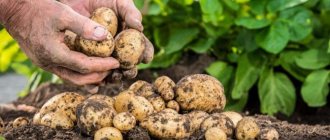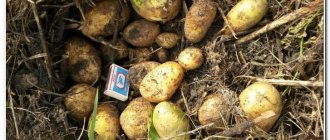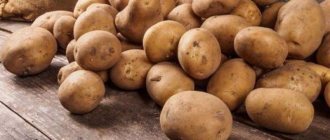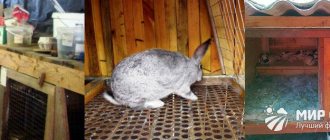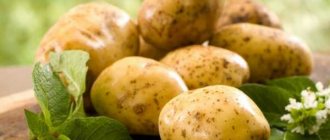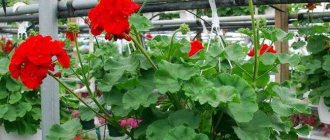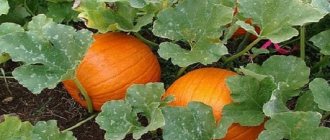In the fall, after harvesting, summer residents are faced with the task of preserving vegetables for the winter, and in particular potatoes, because not everyone has equipped cellars. You shouldn’t be upset: you can leave potatoes for the winter on the balcony, it’s just important to create the right conditions for this.
At what temperature to store potatoes, will potatoes freeze at a temperature of minus 1, what sub-zero temperature can tubers withstand - we’ll talk about this and more in the article.
Optimal storage conditions
Not all potatoes are suitable for storage. Ultra-early and early varieties begin to germinate in the fall, and their taste noticeably decreases. If there are a lot of early tubers, then it’s worth trying to save them. But the storage conditions for such potatoes must be carefully observed. Middle and late varieties are more shelf-stable, the temperature indicators for them are identical to the early ones, but at the same time they are less susceptible to rotting.
- Dug up
- cleared of pieces of earth,
- Place the root vegetables on a tray to dry in the air in the shade for 3-4 hours.
- Then the tubers are placed in a cool, dry room where there is no sun (for several days).
- Afterwards, you can transfer the potatoes to a permanent storage location.
Temperature
Suitable storage temperature for potatoes is +2-+4°C . The fact is that such indicators stop biochemical and physiological processes in the culture, and the growth of tubers and sprouts finally stops.
A decrease to 0°C or minus values should not be allowed.
When frozen, a chemical reaction occurs during which starch breaks down and sugar is released. This primarily affects the taste. The shelf life of vegetables is significantly reduced, and vitamins are lost.
The thermometer will tell you the exact temperature
It should be noted that temperature changes occur during the entire storage period. If there are only a few potatoes, it's not a big deal. But temperature fluctuations in hangars can become a critical factor for large harvest volumes.
Attention! It is necessary to limit the entry of light into the storage so as not to cause the synthesis of solanine. In large quantities, the substance is poisonous to animals and humans. You can identify a vegetable with solanine by color. The color of the peel in this case will be green.
A thermometer is an assistant in maintaining temperature conditions. It should be located half a meter from the door.
If the winter turns out to be cold, and the temperature in the cellar is close to zero, then the crop must be covered. For this you can use straw, sawdust, dry sand, burlap and even a blanket. Another option is to insulate the walls in advance with tarpaulin or other modern materials.
With the arrival of spring, the temperature, on the contrary, rises. Maintaining indicators at a given level is not easy. In small basements, frozen eggplants with water help, which release the cold when thawed.
Humidity
An equally important indicator for long-term storage of potatoes is humidity.
The optimal indoor humidity value is 75-80%.
If the indicators are higher, then there is a risk of mold development. Dampness can be determined by condensation. Moisture appears on the first rows of potatoes. The vegetables begin to rot, and in this case it is unlikely that the remaining harvest will be saved.
Psychrometric hygrometer
To determine the exact humidity, it is recommended to install a psychrometric hygrometer. If the indicators are reduced, then you can increase the level using a sprayer. Fill the eggplant with cool water and spray the liquid onto the walls. This is enough to raise the indicators by 5-10% for about a few days.
When there is not enough moisture in the room, the root vegetables will dry out.
If the humidity, on the contrary, is high, then desiccant agents, such as sand or charcoal, will help reduce it. One bucket of dry sand will be enough for a room with a volume of 3-4 sq.m. Sand or coal needs to be changed periodically.
For your information! Beets are a good companion to potatoes during long-term storage. The vegetable easily tolerates high humidity and rarely gets sick, so you can spread the beets (roots down) in 1-2 layers on top of the potato tubers.
An important storage rule is room ventilation. High humidity combined with low temperature will reduce the shelf life by several months, as the fruits will rot very quickly.
What you need to know about the influence of tuber varietal on the choice of storage temperature
The dormant period of the plant organism is directly related to the duration of the growing season. In relation to potatoes, the dependence is manifested in the difference in shelf life of tubers belonging to varieties of different ripening periods.
Early and mid-early potato varieties are not intended for long-term winter storage. These are “Aurora”, “hostess”, “Rocco”, “Peter’s mystery” and others. Dug up young potatoes with delicate skin quickly lose their presentation and deteriorate.
After ripening (criterion - the peel has become strong), tubers of early varieties can last 4-5 months at a temperature of +2...+4 °C. Typically, summer residents plant early varieties in small quantities - enough for daily consumption of young tubers and storing seed for storage.
“Atlant”, “Yavir”, “Zhuravinka”, “Zdabytak” and other varieties of mid-late and late ripening are ideally suited for storing for long-term winter storage. Long-term - until May-June inclusive.
The above does not mean that late varieties of potatoes do not require special storage conditions.
Tubers of late-ripening varieties have a longer dormant period and are adapted to long-term storage in optimal conditions of +2…+4 °C. At the end of spring, such a temperature in the potato storage can only be maintained with the help of special equipment, which is actually feasible in practice when harvesting potatoes only on an industrial scale.
At the end of spring, closer to the end of the shelf life, maintaining the temperature-humidity balance becomes especially important.
Storage methods
There are several storage methods, where and how to place root vegetables. The main thing is that there is no sub-zero temperature.
Potato harvest
In the cellar or basement
The most popular storage option is a basement or cellar. But even here, agronomists offer different placement methods.
- In bulk . The potatoes are scattered neatly into the bottoms; the skins should not be damaged so that the root crops last longer. The height of the embankment should not exceed 1 meter. Since there is a possibility that the lower layers will begin to rot and spoil the upper and middle ones. It is desirable that air circulates between the boards. For this, holes or cracks are made. To prevent mold on tubers, they are placed at a distance of 10-15 cm from the wall. Or you can secure a moisture-absorbing mat between the fence and the wall.
Bulk storage
- In boxes . The material of the boxes can be wood or plastic. The main thing is ventilation. The presence of a grid in the box is a prerequisite. To absorb excess moisture, a sawdust flooring is made on the bottom of the box. The height of the potato layers should be no more than 30 cm, then it is convenient to stack boxes or crates on top of each other. At the same time, you can track in time which particular box the spoiled root crop appeared in so that you can immediately remove it.
Storage in boxes
- In bags . The fabric material should be breathable, such as thick cotton or burlap. The poured root vegetables should be of small height, approximately 40-50 cm, to reduce the likelihood of rotting.
Storage in bags
Attention! To prevent the possibility of diseases, you can cover the top layer of potatoes with onion peels, branches of rowan, juniper or wormwood. The smell and phytoncides contained in plants drive away unwanted rodents, extending the shelf life of the product.
According to statistics, gardeners have small cellars, about 5-7 sq.m. But if the height of the room allows, then it is more rational to arrange the boxes on top of each other with a height of 1.5-2 meters. This way, the root crops will not be piled on top of each other, the risk of rotting will be reduced, and everything inside the basement will be neat and tidy.
Personal experience of storing potatoes in the cellar
On a balcony, loggia or garage
An option for those people who do not have a nearby cellar or basement for storing potatoes. The balcony can be insulated, in which case you only need a ventilated container for storage, or it can be cold, but you will have to insulate the crop.
Storage on the balcony in an insulated box
How to make a warm box:
- select 2 containers so that one is larger than the other around the perimeter by about 4-5 cm;
- A layer of insulation is laid between the boxes : polystyrene foam, sawdust, sand;
- Carefully lay out the potatoes in several layers, cover with a lid or plywood on top.
If the temperature on the balcony drops to -3-5°C , then the box can be slightly warmed up. Place a hot water bottle or a lamp on top, but first cover the potatoes with a dark cloth. In severe frosts, savvy gardeners covered containers on the balcony with a blanket heated at minimum setting.
From the means at hand at home, you can pour vegetables into a cardboard box . Place a layer of sawdust or sand on its bottom, make several holes on the sides for air circulation, distribute the root vegetables and cover.
If you have a mobile refrigerator , then that will also work. The refrigerants are removed, the vegetables are added and the lid is closed. Foil insulation will keep you warm. But periodically the lid needs to be opened for ventilation. The culture can be stored in such a balcony container for 1 to 3 months.
If the size of the loggia allows, then you can construct a box-sofa from clapboard. Knock down a frame from chipboard, cover it with plywood, and attach a lid on top. This balcony cellar is suitable both for storing things and for wintering vegetables.
Storage in a box-sofa
Regarding the garage, it is worth noting that in this case a lot depends on how the room is equipped. If there is a shallow, warm basement inside, then most likely the tubers will begin to germinate in early March, when the average daily temperature rises. If the cellar inside the garage is from 2 to 5 meters, then this is a good option for long-term storage. Having ventilation will help prevent dampness.
In the apartment
Storage in the apartment
Potatoes do not keep warm for long. The average temperature in an apartment building is +20+24°C. The culture will remain in such a room for several weeks, maximum 1.5 months. Then it will begin to wither and sprout.
The refrigerator is also not the best option. Firstly, potatoes take up a lot of space, secondly, there is minimal air flow to them, and thirdly, the humidity in the device fluctuates due to frequent opening of the door. And vitamins, micro- and macroelements are destroyed under the influence of cold.
Secret! When, while digging up a crop, you come across a strong and healthy bush, you should leave all the tubers from this plant for seeds. The yield from such potatoes is 50% higher compared to those selected individually from all bushes.
It is most rational to store seed material in the apartment in order to take it out into the warmth in time and prevent hypothermia.
In a specialized vegetable store
The place where the tubers remain marketable for six to 10 months is a vegetable storehouse. In industrial structures, the culture is in large volumes and from here it reaches store shelves. The storage temperature of potatoes in the vegetable store is carefully observed. In such a place, the crop cannot be allowed to rot.
Vegetable store
The average temperature in the hangar for long-term storage is +2+3°C, and for storage for a couple of months +4+6°C. The relative humidity for potatoes in storage is maintained at 70-85%. There must be ventilation to maintain normal air exchange.
On a note! Often in large specialized vegetable storage facilities, the crop is treated with antifungal agents, such as phytosporin or bactofit. Therefore, it is undesirable to eat such a product together with the peel; it must be cut off.
A basement, cellar or garage serves as a home vegetable storage. The depth of any room to store potatoes must be at least 2 meters.
At what optimal temperature can you store potatoes in winter?
It is not easy to maintain optimal storage conditions for potato tubers in winter (+2…+4 °C at a humidity of about 90%) - this requires, at a minimum, a well-equipped cellar prepared for the season, or better yet, a specialized potato storage facility. Therefore, when choosing a storage method and temperature, they proceed from an assessment of the specific situation: “what” they are going to store and “for how long”.
Long-term storage
For successful long-term storage of tuber crops throughout the winter, until a new harvest, special conditions are required - constant temperature and humidity. The main task is to prevent temperature changes.
Even a short increase in degrees can cause dormant eyes to sprout and potatoes will lose quality.
Optimal temperature conditions of +2...+4 °C for such a long time can only be maintained in industrial-scale potato storage facilities, which are owned by large agricultural producers.
Spring storage
At the end of their storage period, potatoes are especially sensitive to temperature changes. Only tubers of late varieties retain good consumer properties during this period. A summer resident can use sprouted potatoes to obtain planting material to grow an early harvest.
Short term
Potatoes, as already noted, are not perishable products and can be stored at home for quite a long time without loss of quality. To do this, it is important to meet certain conditions:
- lack of access to sunlight;
- temperature not higher than +20 °C;
- adequate ventilation;
- air humidity not less than 80%.
In such conditions, tubers without signs of disease can remain until the new year.
If we are talking about short-term storage of potatoes in the period after the New Year (the potatoes were taken from the cellar), it will not be possible to maintain their quality for a long time. As soon as the vegetable “feels” the heat, the growth mechanism is activated - the tubers become flabby and sprout. But this is not the worst thing: at the same time, solanine, a nightshade alkaloid, begins to be produced. These potatoes are dangerous to eat.
Maximum and minimum temperature
With the minimum temperature limit for storing potatoes, everything is simple - 0 ° C, when the breakdown of starch into sugars begins.
The upper limit of the temperature regime cannot be defined so clearly. Various factors come into play.
- Tubers easily tolerate short-term storage (1-2 weeks) at temperatures above room temperature with high air humidity (not to be confused with dampness!). The main danger is loss of moisture and germination. Being in a dark place helps to delay the growth process.
- If force majeure happens (a hot water pipe bursts, for example), the tubers can withstand a short-term increase in temperature up to 80 °C. Such potatoes lose their germination, but the nutritional value of the product is preserved.
Until the new year, potato tubers are in a dormant state and are stored better when compared with keeping them under similar conditions, but in the spring.
Preparing potatoes and storage for storage
When the tops begin to dry and turn yellow, this is a sign that the crop is ready for harvest. Digging is done in dry weather.
Why is it important to dry the tubers in several stages? First, this is done in the air (at t = +14+17°C ), then in a barn ( +10-+12°C ), and only then put the vegetables in a cellar or basement, where the optimal temperature for storage does not exceed +5° WITH .
Thanks to this scheme, there is a gradual decrease in the temperature that the potatoes can withstand. The product retains its high-quality presentation, the likelihood of disease and, as a result, rot is reduced.
Basic principles of storage preparation :
- clean from dirt, remove the remains of other crops;
- ventilate the room;
- disinfect with special preparations, for example, fumigate with sulfur.
- Sealing the walls and floors will help protect your storage from mice and other rodents.
The steps are simple, but take time.
Basement treatment
Primary requirements
The main requirement is a dark and cool place. To keep potatoes longer, do not forget to ventilate and dry the room.
Vegetable growers advise whitening the walls and ceiling where vegetables are stored. This is done to prevent mold from forming. Also check the room for holes and cracks; if there are any, be sure to seal them.
Optimal temperature
At what temperature are potatoes stored? Make sure that the room temperature does not exceed 4 degrees. But you should not make it below this mark, as the potatoes will lose their taste. The maximum permissible temperature is 7 degrees. At 0 degrees and below, the vegetable freezes, becomes sweet and unusable, and soon rots.
Humidity
Humidity must be maintained around 85%. Low or too high humidity can harm potatoes. If the air is very dry, place containers with water, moisture will evaporate from them.
Illumination
Tubers are stored in the dark. Be sure to hide the vegetable from direct sunlight.
Potato response to temperature
How to understand at what temperature potatoes freeze on a balcony, cellar, barn, garage or any other place? For the root crop to freeze, 2-3 days of being outside or in a place with negative temperatures is enough. A frozen root vegetable can be detected by its appearance by placing it in a warm place. The vegetable will wrinkle, darken, and become soft. It will taste sweetish.
Potatoes freeze as quickly as they dry out. The moisture leaves the tubers, the product withers, the peel becomes thick, and the taste changes to bland.
Conclusion : storage temperature for potatoes in winter is from +2 to +5°C. Anything higher or lower has an adverse effect on root crops.
At temperatures below +1°C, potatoes can be frozen, and if -1°C and below, then the potatoes gradually turn into ice.
Spoiled tuber
How to properly prepare potatoes
After digging, the potatoes are not immediately sent for storage. The tubers are dried, ripened, and mechanical damage is healed.
Air-sun bath
If the weather is good, the tubers are scattered to dry on the arable land; in rainy weather they are taken under a canopy. The potatoes are kept in the sun for no more than 2 hours, then dried for 2 weeks in a barn or under a canopy. Ultraviolet rays, they make up 10% of the spectrum of sunlight, have a bactericidal effect, kill fungi and bacteria, and increase the shelf life of potatoes.
Healing
It is impossible to avoid mechanical damage during digging. Infection can occur through wounds on the skin. They dry out quickly and become covered with dry skin at a temperature of 13-18 °C. Healing takes no more than 2 weeks. If the temperature is lower, the process is delayed up to 3-4 weeks.
Falling asleep
Before being sent for storage, the tubers must undergo a period of gradual cooling. In industrial potato storage facilities, the temperature is reduced daily by 0.5 °C. The process lasts 10-15 days. The weather helps the summer residents. When the air temperature drops to 2-4 °C, the potatoes are sent for storage. Thanks to the gradual decrease in temperature in the tubers, all processes (physiological, biochemical) stop.
What to do with frozen potatoes
There is nothing critical about a frozen vegetable; it is edible. But the taste changes due to the breakdown of starch. If you don't like this product, there are options for using it:
- Feeding livestock.
- Preparation of starch.
- Deep fry or make potato pancakes. Draniki will not darken if the vegetable is only slightly frozen.
Draniki from frozen potatoes
It is worth remembering that when the product is not very frozen, it can be revived with the help of heat. Place the tubers in hot water (50-70°C) for a few minutes. Then peel, cut and cook.
But if the freezing temperature of the potatoes turns out to be too low, and the tubers are deeply frozen and quickly turn black, then all that remains is to dispose of them.
Spring cold
Another important point that worries vegetable growers is how many degrees the potatoes planted in the ground can withstand. Spring frosts often spoil the mood of summer residents with their unexpected return, and some simply plant tubers and do not control the process of warming the earth. Cold and wet conditions are detrimental to the crop.
Root vegetables are placed in an earthen layer when it has already thawed and is sufficiently dry. If the soil temperature has not reached at least +6°C, the seed potatoes may rot without having time to produce a single sprout.
If green shoots have already emerged, but frost returns, the foliage may turn black. However, subsequent warmth will allow the sleeping buds to wake up, and the potatoes will begin to grow again. If the cold snap lasts for a long time and does not go away during the day, it may not be possible to grow a crop. Summer residents sometimes protect small areas of plantings with covering material. With huge potato fields this is more difficult to do.
It turns out that the crop can withstand light frost from 0 to -2°C, but a decrease of even 1-1.5° leads to poor germination and a slowdown in further plant development. The optimal temperature range for potato growth is between 8 and 25 °C.
Temperatures above 25 °C also adversely affect its growth. The tubers simply stop setting.
Harvesting time for storage in winter
The tubers ripen in about 90 days from the moment of planting - the collection time depends on the day of planting. Of course, everything is relative, focus on the weather and your preferences.
Generally accepted harvest times for potatoes:
- At the end of July and beginning of August, early potato varieties are harvested.
- From August 10 to August 30 – medium ripening varieties.
- From the end of August to September 15 - late varieties.
You can dig up potatoes after the 15th, but there is a danger of exposing the tubers to excess moisture due to autumn rains.
Autumn frosts
Sometimes the owners of a landscaped plot fail to harvest on time, and the cold weather in the fall gets closer and closer. It is worth figuring out how much frost the potatoes can withstand in this case, and whether it is possible to dig up the tubers unchanged.
It all depends on the duration and severity of the frost. Typically, the first temperature jump to negative values lasts about 14 hours and does not cross the -5°C mark on the thermometer. Loose soil fertilized with organic matter does not freeze under such conditions. The still quite active process of decomposition of substances generates a lot of heat.
If the thermometer drops below -10°C at night , you should probably wait to dig it up. In mid-autumn, frosts are still short-lived, and you can postpone the harvest until more acceptable temperatures.
Potatoes are considered a cold-resistant, unpretentious crop, but summer residents have problems with them too. It is important to remember what conditions she prefers and try to comply with them. Open air temperatures can easily ruin your precious harvest.

